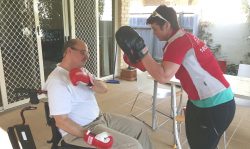Everyone knows that exercise is important for your health and wellbeing, but what about exercise for people who have physical disabilities? The recommendation is for ALL Australians to achieve 30 minutes of exercise every day. It’s even more beneficial for people with disabilities as they tend to be more sedentary.
Barriers to overcome
Many of the traditional ways to exercise can seem challenging if you have a physical disability like CP that results in loss of motor skills, strength or muscle control, or being confined to a wheelchair. Many standard big box gyms may not have the capacity to accommodate these issues. Don’t worry! There are lots of things you can do, let’s explore some of these options.
What can you do?
The fact is, there are many different types of exercise and types of movements that anyone can do, depending on your disabilities. Every aspect of your health and fitness can be trained and be improved through the right type of exercise. Many of these can be done at home or with minimal equipment.
- People in wheelchairs can work on upper body and core – things like boxing and weight training can be completed in a seated position.
- People with limited grip strength can work with wrist weights and grip squeeze balls. Even small improvements can make daily tasks like getting dressed and preparing food so much easier!
- Balance can be trained and improved by working on 1 leg, standing on unstable surfaces, performing simple step over and balance movements.
- Cardiovascular health can be trained by getting your heart rate up and deep breathing for 20 minutes or more – things like walking, jogging, boxing, swimming, rowing and biking – basically anything you can do for a sustained period of time to keep your heart rate up.
- Muscle strength and endurance can be trained by simple movements lifting your own body weight, free weights, medicine balls and resistance bands.
- Flexibility and range of motion can be improved through regular stretches for the major muscles and joint.
Intensity
Exercise does not need to be extremely vigorous to be helpful, for people who are very inactive, just a slight increase in activity will result in health benefits. A little activity is better than none at all, and more activity is even better.
Health benefits
Regular exercise has a large number of physical health benefits including
- Maintaining a healthy body weight
- Improved quality of sleep
- Increased bone density
- Improved muscle strength
- Better energy levels
- Increased lung capacity
- Increased endurance and stamina
Registered NDIS Provider


If you need a hand getting started, working with a Fitness Enhancement Personal Trainer can help with some of the common issues that prevent people getting started with exercise. We can come to you in the comfort and privacy of your own home, or in one of our 100% private Training Studios.
Fit Your Ability, a division of Fitness Enhancement, is an NDIS registered provider for Core and Capacity Building registration. No matter your disability or your goals — whether it’s sport, fitness, exercise, or recreation — our team is here to help.
Enquire today to find out more.
